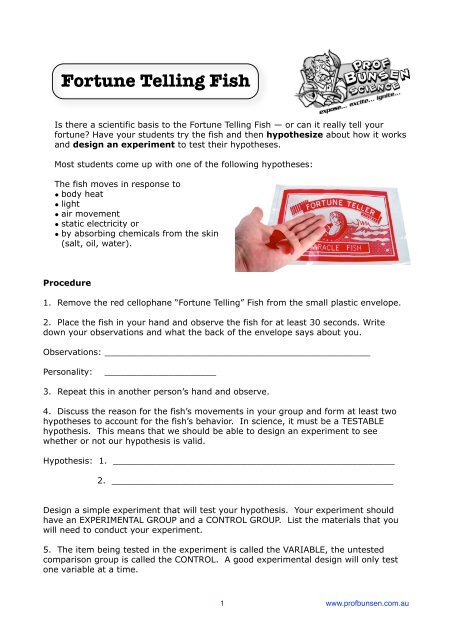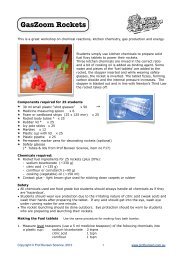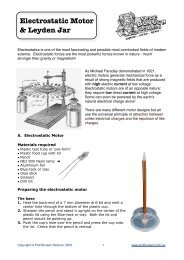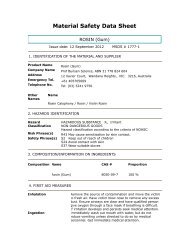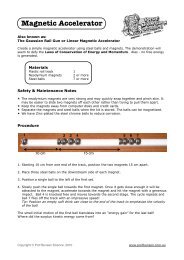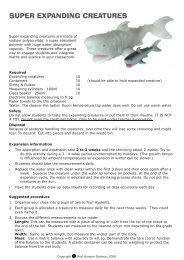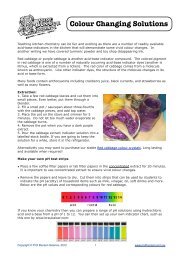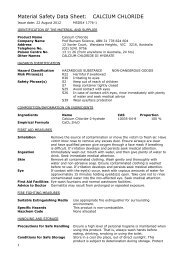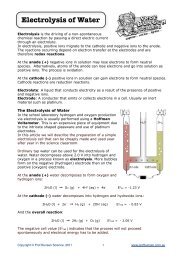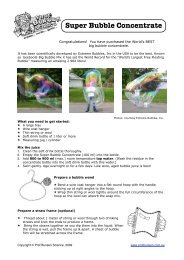Fortune Telling Fish - Prof Bunsen
Fortune Telling Fish - Prof Bunsen
Fortune Telling Fish - Prof Bunsen
- No tags were found...
You also want an ePaper? Increase the reach of your titles
YUMPU automatically turns print PDFs into web optimized ePapers that Google loves.
<strong>Fortune</strong> <strong>Telling</strong> <strong>Fish</strong>Is there a scientific basis to the <strong>Fortune</strong> <strong>Telling</strong> <strong>Fish</strong> — or can it really tell yourfortune? Have your students try the fish and then hypothesize about how it worksand design an experiment to test their hypotheses.Most students come up with one of the following hypotheses:The fish moves in response to• body heat• light• air movement• static electricity or• by absorbing chemicals from the skin(salt, oil, water).Procedure1. Remove the red cellophane “<strong>Fortune</strong> <strong>Telling</strong>” <strong>Fish</strong> from the small plastic envelope.2. Place the fish in your hand and observe the fish for at least 30 seconds. Writedown your observations and what the back of the envelope says about you.Observations: __________________________________________________Personality:_____________________3. Repeat this in another person’s hand and observe.4. Discuss the reason for the fish’s movements in your group and form at least twohypotheses to account for the fish’s behavior. In science, it must be a TESTABLEhypothesis. This means that we should be able to design an experiment to seewhether or not our hypothesis is valid.Hypothesis: 1. _____________________________________________________2. _____________________________________________________Design a simple experiment that will test your hypothesis. Your experiment shouldhave an EXPERIMENTAL GROUP and a CONTROL GROUP. List the materials that youwill need to conduct your experiment.5. The item being tested in the experiment is called the VARIABLE, the untestedcomparison group is called the CONTROL. A good experimental design will only testone variable at a time.1 www.profbunsen.com.au
Here is an example of an experiment design:VariableExperimentalControlAction <strong>Fish</strong> 1 <strong>Fish</strong> 2 <strong>Fish</strong> 3HeatMoistureLightAirElectricityPlace fish onpaper close tomild heater /sunWet a papertowel with 3drops of waterand place fishon towelPlace fish onpaper underdesk lampPlace fish onpaper in draftfrom fanPlace fish onpaper, rub aballon on hairand bring closeto fishMaterials:<strong>Fortune</strong> <strong>Telling</strong> <strong>Fish</strong> in plastic wrapper (cellophane fish)Water, Paper towels, desk lamp, fan, heater, balloonObserve, record and discussMake careful observations of the movement of the fish. How quick it responds isimportant too. For instance: A fish in the sun may curl too but how does the tempocompare with the curling on the hand and wet towel? Discuss the influence secondaryeffects have on your results such as the evaporation of moisture by heat in the sun.Conclusion:_______________________________________________________________________________________________________________________________________________________________________________________The cellophane fish curls and twists primarily because it absorbs moisture from sweatglands in the hand and subsequently loses water due to evaporation. The fish is madefrom a cellophane polymer that is hygroscopic, (“Hygro” means water and “scopic”meaning to view or find.)2 www.profbunsen.com.au
As water is absorbed into the cellophane fish, the water moves through small pores inthe cellophane by a process called capillary action. The side of the fish touching thehand absorbs more moisture and the cellophane begins to swell causing the fish tocurl up. The heat of your hand causes some of the water to evaporate. The lightnessof the cellophane makes the fish very susceptible to air currents, which adds to the“dancing” effect. As people are different, the absorption/evaporation process happensat a different rate.When the fish is placed on a warm dry surface, it flattens out since the moistureevaporates and no new moisture is added. Placing the fish on the wet paper towelcauses the fish to curl as it did in the hand because it once again absorbs water.References1. Teaching Chemistry with Toys, McGraw-Hill & Terrific Science Press, Center forChemical Education, Miami University, Middletown, USA2. Joyce Brumberger, Florida Polymer Ambassador, 2004, Polymer Ambassador WebSite: www.polymerambassadors.org3 www.profbunsen.com.au


